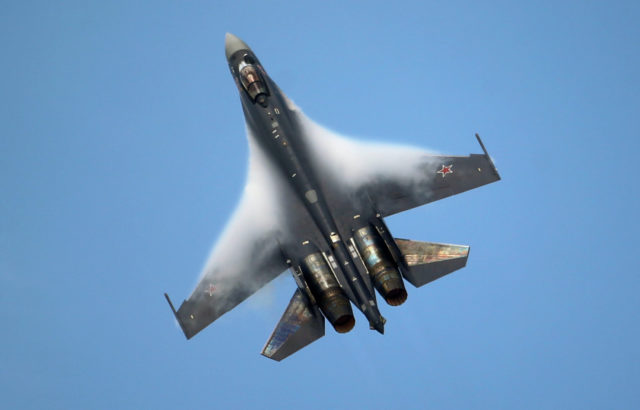
Moscow Now Wants Missiles Rather Than a Base in Belarus, Minsk Analyst Says
Publication: Eurasia Daily Monitor Volume: 15 Issue: 10
By:

Technological breakthroughs in Russian military aviation and the expansion of a Russian airbase in Kaliningrad mean that the opening of a Russian military airfield in Belarus would do less for Russia’s defense posture than many had thought only a few years ago. At the same time, there are fears in Moscow that continuing to press Minsk on this point could provoke a Maidan-style revolution in Belarus. Together, those developments suggest the Russian government has stopped its campaign for a base there, according to Belarusian defense analyst Aleksandr Alesin. Instead, Moscow appears to be pushing President Alyaksandr Lukashenka to allow the installation of Russian ballistic missiles in his country.
In a commentary for the online portal Belrynok, Alesin describes in detail the changes in Russia’s military aircraft over the last five years. The new generation of Russian planes can fly farther, faster and carry much heavier loads. Thus, to reach potential European targets, these aircraft no longer need to be based in Belarus, as Russian defense planners had assumed as recently as 2012. Moreover, he continues, the growth of the Russian base in Chkalovsk, Kaliningrad, over the last few years has also reduced the need for a base in Belarus. Consequently, Russian defense planners appear to have bowed to those in Moscow who say that continuing to demand the opening of a Russian base in Belarus will not only disturb Russia’s Western neighbors—possibly leading them to take new defensive measures of their own Moscow would then have to counter—but also quite possibly provoking an anti-Russian political revolution in Belarus itself. And were the latter development to come about, this would quickly eliminate any value the establishment of a base on Belarusian territory might have anyway (Belrynok, January 17).
The latest modifications of the Russian Su-27 fighter include stronger engines and significantly improved avionics and radar, particularly in the Su-27SM3 model. Additionally, the even more advanced Su-35, with vastly improved look-down radars and improved optics, has recently come online. As result, Moscow can achieve the same goals with planes based farther from the frontline than it would have been able to do in the past, the Belarusian military analyst says. Indeed, Alesin argues, “in air actions, the Su-27SM3 is almost twice more effective than its predecessor, the Su-27S; and in ground actions, its effectiveness is more than three times as great” (Belrynok, January 17).
Those improvements have changed the calculus of Russian military planners regarding the need for a base in Belarus, he continues. But perhaps even more important has been the dramatic expansion of Russian military aviation in the Russian exclave of Kaliningrad. In March 2010, the Pokryshkin air squadron, which Moscow earlier announced had been disbanded, was re–formed into a regiment at the 7,054th Russian base in Kaliningrad. This new air regiment was equipped with significantly upgraded weaponry in order to protect Russia’s Baltic Fleet, which is based there.
Although the primary task of this unit is to defend the Baltic Fleet and Kaliningrad Oblast, its weaponry also will allow it to attack regional ground and naval units of the North Atlantic Treaty Organization (NATO), should that be required. Its complement of planes is currently being upgraded from the Su-27Ss that it had used before, to the more advanced Su-27SM3s. And that in turn means, Alesin argues, that its forces can be used not only over Kaliningrad and the Baltic Sea but over Belarus as well.
Together, these two developments—the modernization of Russian planes and the buildup of the Russian base in Kaliningrad—have reduced Moscow’s need for an airbase on Belarusian territory. But in addition, according to Alesin’s sources, it has reinforced the view of many in the military and political leadership of Belarus: they are likely now even more resistant to the Russian idea of creating a base on Belarusian territory. Whereas Moscow, out of political calculations, is no longer pushing so hard on this topic either.
Russia’s effort to push Belarus to allow a Russian airbase on its territory began in April 2013, when Defense Minister Sergei Shoigu presented the idea at a Minsk meeting with Lukashenka. The Belarusian leader did not outright say “no,” but he did not agree to the proposal either. Six months later, however, Lukashenka gave a more definitive answer: “We do not need any bases.” The statement was welcomed by many Belarusians, but it infuriated Moscow (Belrynok, January 17).
The story did not end there, however. Just before the scheduled meeting of Lukashenka with Vladimir Putin in November 2015, General Aleksandr Lyapkin, the head of the operations administration of the Main Staff of the Russian Air and Space Forces, spoke about the need to “remind the head of Belarus” about the need for a Russian base there. Ultimately, the meeting of the two presidents never took place. And since that time, Alesin says, “the issue of a Russian airbase in Belarus has been raised ever more infrequently.” Nonetheless, he acknowledges that many observers continue to insist Moscow is only waiting for “a suitable moment” to press the issue again.
“Is the question closed?” the Belarusian defense analyst asks rhetorically. Probably not entirely, because, according to his sources, what Russia wants now is something similar but not exactly the same: They say that Moscow is much more interested in basing Iskander missiles on Belarusian territory than in opening an inevitably controversial air base. How Belarusians—officials and members of the opposition—will respond to that shift remains to be seen.



